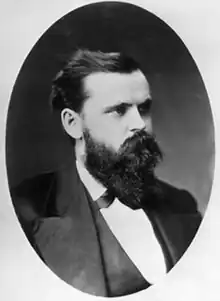Mark Walrod Harrington
Mark Walrod Harrington (August 18, 1848 – September 10, 1926) was an American scientist, the first civilian head of the United States Weather Bureau, and former president of the University of Washington.[1] Considered a prominent scientist in the late 19th century, Harrington studied and published works in multiple disciplines, including botany,[2][3] astronomy,[4] meteorology,[5] and geology, and knew a half-dozen languages.[6] His academic achievements were overshadowed by his disappearance in 1899, when he left home one day and disappeared for many years. His wife and son located him in 1908 at a psychiatric hospital in New Jersey where he had been admitted as patient John Doe No. 8.[7]
Mark Walrod Harrington | |
|---|---|
 | |
| 33rd President of the University of Washington | |
| In office 1895–1897 | |
| Preceded by | Thomas Milton Gatch |
| Succeeded by | William Franklin Edwards |
| Personal details | |
| Born | August 18, 1848 Sycamore, Illinois, U.S. |
| Died | September 10, 1926 (aged 78) |
Biography
Born in Sycamore, Illinois, Harrington was the son of James Harrington and Charlotte Walrod Harrington. In 1878, he married Rose Martha Smith, with whom he had a son (Mark Raymond). Mark Raymond Harrington was a well-known archaeologist.
From 1879 to 1891, he was professor of astronomy and director of the Detroit Observatory of the University of Michigan in Ann Arbor. During this time, he published an astronomical observation recorded by Johan Ludvig Emil Dreyer as NGC 7040 in the New General Catalogue. He founded The American Meteorological Journal in 1884, of which he published the first seven volumes.
In 1891, Harrington was appointed by President Benjamin Harrison as the first civilian chief of the United States Weather Bureau.[8] He served in this role until 1895, when he was ousted by Secretary of Agriculture Julius Morton, who convinced newly inaugurated President Grover Cleveland to let him fire Harrington.[9]
In 1895, he was elected president of the University of Washington to succeed Thomas Milton Gatch.[10] He remained in this office until 1897.
He left his home one evening in 1899 and disappeared for about 7 years. According to news accounts, Harrington had lost his memory but after several years in psychiatric institutions, developed a fondness for music.[11] He died on September 10, 1926, in Morris Plains, New Jersey.
References
- "Mark Walrod Harrington, 1895-97 — UW Libraries". www.lib.washington.edu. Retrieved 2022-03-20.
- "Catalog Record: The analysis of plants. Intended for schools... | HathiTrust Digital Library". catalog.hathitrust.org. Retrieved 2022-07-09.
- "The tropical ferns collected by Professor Steere in the years 1870-75. By M.W. Harrington ..." HathiTrust. Retrieved 2022-07-09.
- "Catalog Record: Mathematical theories of planetary motions | HathiTrust Digital Library". catalog.hathitrust.org. Retrieved 2022-07-09.
- "Rainfall and snow of the United States, compiled to the end of 1891, with annual, seasonal, monthly, and other charts. By Mark W. Harrington ... text". HathiTrust. Retrieved 2022-07-09.
- "The Fault in His Stars | Bentley Historical Library". Retrieved 2022-03-20.
- "Image 14 of New-York tribune (New York [N.Y.]), November 14, 1908". Library of Congress, Washington, D.C. 20540 USA. Retrieved 2022-07-09.
- US Department of Commerce, NOAA. "History of the National Weather Service". www.weather.gov. Retrieved 2022-07-09.
- "Image 1 of The Wichita daily eagle (Wichita, Kan.), July 3, 1895". Library of Congress, Washington, D.C. 20540 USA. Retrieved 2022-07-09.
- "The Seattle Post-intelligencer 22 August 1895 — Washington Digital Newspapers". washingtondigitalnewspapers.org. Retrieved 2022-07-09.
- "Clipped From Harrisburg Telegraph". Harrisburg Telegraph. 1914-03-09. p. 8. Retrieved 2022-07-09.